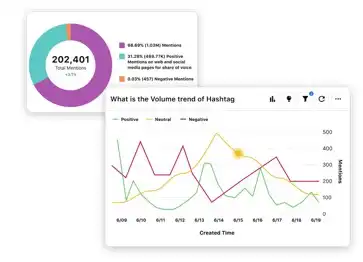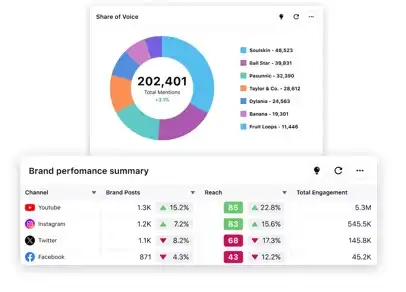The undisputed leader in social media management
For over a decade, the world’s largest enterprises have trusted Sprinklr Social for its in-depth listening, unmatched channel coverage, enterprise-grade configurability and industry-defining AI.

Social Selling Basics to Advance: All You Need to Know
Today, personal connections drive business success. That’s why traditional sales tactics are giving way to more nuanced approaches like social selling. By utilizing social media to connect with prospects, share industry insights and demonstrate thought leadership, you can cultivate relationships that translate into tangible business outcomes.
For C-suite leaders committed to driving innovation in sales methodologies, integrating social selling into your strategy is non-negotiable. Jay Baer articulates this perfectly when he deliberates on social commerce, "Social media creates kinship between companies and customers, and kinship equals purchase intent.” In this article, we break down social selling for you, enabling with all the insights and perspectives you need to leverage it to grow your business.
What is social selling?
Social selling is a modern-age marketing tactic that uses social networks to identify, connect, and nurture relationships with potential customers. Through platforms like Facebook, Instagram, X (formerly Twitter), TikTok and LinkedIn, social sellers interact with their audience with an aim to build connections and drive sales.
Social selling is different from traditional sales tactics since it focuses on strategic relationship building rather than hard selling or direct pitch. By demonstrating value and expertise, dispensed through content and interactions, social sellers win trust and credibility that eventually drive sales.
It’s important to note that social selling is closely related to social commerce but not synonymous. While social commerce facilitates direct sales through social platforms by orchestrating frictionless shopping journeys from awareness to sale to support, social selling plays more of a supporting role in the sales cycle. It focuses on building relationships and engaging prospects, positioning you as a trusted resource when they are ready to buy.
Social Selling: A 2-minute Overview
Here’s a short video about the basics of social selling and how it helps build genuine connections, attract quality leads and outpace competitors on crowded social platforms.
5 benefits of social selling
Social selling works in the 21st century as it’s rooted in brand authenticity and convenience which the modern shopper craves. For businesses, its benefits are myriad but here are the top 5 to consider:
- Meet customers where they are: About 76% of the social media users claims to have shopped based on a social media suggestion. Social platforms like Facebook and Instagram have become a thriving marketplace for all kinds of businesses — big or small — to sell directly from the comfort of their homes without having to set up independent stores or even websites.
- Fosters brand loyalty: According to the above research, 53% of customers who follow brands on social media tend to be more loyal to those brands, making social platforms a powerful way to build customer loyalty and long-term relationships.
- Provides high-quality leads: Social selling tactics such as influencer marketing, user-generated content (UGC) marketing and targeted advertising lead brands to high-intent leads. Just adding UGC to marketing has helped brands boost conversions by 29%
- Widens reach and visibility: Social selling allows businesses to reach a broader audience by leveraging social media platforms. This increased visibility helps attract potential customers who might not be accessible through traditional sales methods.
- Shorter sales cycles: Social selling shortens sales cycles because it allows direct engagement with customers and decision-makers alike, fostering trust through personalized interactions. A LinkedIn research claims that 64% of sales reps who use social media hit their team quota, compared with 48% who don’t sell on social.

How does social selling work?
The social selling process involves identifying potential customers by monitoring social media activity, such as likes, shares, and comments, and then engaging with them in a personalized manner. By consistently interacting with prospects and offering helpful information, brands establish themselves as trusted advisors. This approach helps nurture leads and nudges them into the sales funnel, culminating into conversions on social media.
There’s also an element of monitoring relevant social media mentions to jump in at opportune times such as when customers express dissatisfaction with your products or one of your competitors. It also entails tracking customer sentiment and competitor insights across social platforms, revealing deeper insights about your customers, competitors and industry in general. Ultimately, this intel can be used to generate high-quality leads through personalized outreach, nurture customer connections and drive brand recall.
The key elements of social selling
An effective social selling strategy combines 5 key pillars to build genuine customer relationships and drive business growth.
1.Effective branding:Brands with an identifiable social media persona stand out on cluttered platforms and attracts the right prospects. To do this, build a value-centric profile, follow a social media style guide, share on-brand content and visuals, maintain a strong brand voice in content as well as messaging.
2.Social listening: Social listening involves monitoring and analyzing social media platforms for relevant brand mentions, industry trends and customer sentiments, preferences, and behaviors. This can help you tune in to your customers’ evolving needs.
3.Effective prospecting: This is crucial in social selling because it’s a targeted approach to identify and connect with the right potential customers, ensuring that efforts are focused on those most likely to convert
4.Content sharing: Based on audience insights, you must share relevant and engaging content consistently to increase visibility and engagement.
5.Relationship building: Remember that social selling isn’t just about sales, it’s about nurturing relationships. To do this, you must actively engage with customers, respond to queries and provide customer support on all social platforms.
6.Brand advocacy: Influencers, employees and satisfied customers share genuine enthusiasm about your brand/products, driving interest, reach and credibility far better than self-promotion. Social selling strategies that encourage customer advocacy, employee advocacy and influencer marketing have a far higher success rate than those that don’t.
🌟Fenty Beauty’s Masterclass on Social Selling
Rihanna’s Fenty Beauty is a perfect example of brands using social media in the beauty industry smartly and effectively. To replicate its success, focus on these pillars of social selling:
- Inclusivity: It is one of the first beauty companies to have a 40-shade foundation line, now expanded to 50 shades to cater to all skin colors.
- Brand presence: Rihanna’s strong personal brand amplifies the company’s position, as seen when her casual on-stage touch-up during the 2023 Super Bowl led to a surge in online searches and a $5.6 million media impact.
- Social proof: The brand excels at social listening and content sharing, balancing user-generated posts with tutorials to highlight its range.
- Relatability: It uses brand advocacy by engaging influencers and empowering customers to spread the word.

For more inspirational examples, check out the article below:
4 best platforms for social selling
The right platform for social selling depends on the type of business, target audience, tech stack and preferred engagement methods. Here are the 4 most popular platforms to consider:
1. Facebook
Suitable for: Brands operating in retail, e-commerce, CPG, food and beverage and SaaS B2C companies like retail and e-commerce.
Facebook is the preferred social selling platform for 200 million brands that use the platform to host virtual storefronts and build connections every month. Its massive adoption is driven largely by its mammoth user base, varied content types, and diverse selling tools including:
- Facebook Shops: Great for creating storefronts to sell products directly through the platform.
- Facebook Groups: Help foster community-based engagement, build credibility and nurture long-term relationships.
- Targeted advertising: Facebook’s ability to host targeted ads and facilitate Messenger conversations ensures personalized follow-up with leads. It also offers audience segmentation and advanced ad targeting for personalized outreach.
Also read: Step-by-Step Guide to Facebook Advertising
2. LinkedIn
Suitable for: B2B social selling such as enterprise or SaaS products as well as brands targeting decision-makers.
LinkedIn marketing strategies that target niche industries and decision-makers can be useful for relationship-building and thought leadership content. Some of its useful features include:
- Sales Navigator: This tool offers advanced search filters and is especially useful for lead generation via social media.
- InMail: This feature makes direct outreach simple.
- Social Selling Index (SSI): Helps track engagement and sales effectiveness, offering insights that can be used to improve social selling efforts.
Also read: The Complete Guide to LinkedIn Advertising
3. Instagram
Suitable for: B2C brands like lifestyle and retail that can build on visual appeal
Instagram marketing is great for its visual format which makes it a great tool for brand storytelling and personalized connections, especially for B2C sales.
- Instagram Shopping: Lets businesses tag products directly in posts and stories, creating a seamless shopping experience.
- Live and Stories: Creates virtual selling spaces where businesses can engage in real-time with their audiences, answering questions, providing product demonstrations and flash sales that foster authentic interactions. It also makes other social selling strategies like influencer collaborations and UGC more streamlined.
Also read: Everything to Know About Instagram Advertising
4. X (formerly Twitter)
Suitable for: Support-led businesses like hospitality, travel and tech
X’s (formerly Twitter) short and nifty Tweets allow for real-time, quick interactions with customers and prospects. The platform’s immediacy and transparency help brands address concerns and provide value instantly. Responsiveness is a hallmark of customer-centricity, which is a powerful driver for sales. To leverage the platform for social selling, take advantage of its noteworthy features:
- Ads: Offers a wide variety of ad formats, such as single image ads, video ads, moment ads, dynamic and collection ads, to name a few.
- Lists: Helps businesses organize followers into specific categories.
- X (formerly Twitter) Spaces: Enables live audio interactions that can humanize the brand.
- Advanced search: It is also a great platform to track customer sentiments using features like advanced search that allows tracking through specific keywords or hashtags.
Related read: How to Advertise on Social Media Platforms
Is your target audience young and addicted to TikTok? Check out our ultimate guide to TikTok marketing to learn the best ways to reel them in.
How to get started with social selling
To kick off a successful social selling strategy, you need to be proactive, engage with your audience meaningfully and use the right tools. Here are 10 practical steps to help you get started:
1. Optimize your social profile
Optimizing your social media profile is the first step in your social selling strategy. An optimized profile makes a memorable first impression. It must convey who you are, what value you bring and why someone should engage with you. You can do these by:
- Crafting a strong value proposition
- Using the right keywords for visibility. For eg. B2B sales, customer relationship management or specific tools you specialize in like social listening
- Highlighting achievements and social proofs
- Keeping the tone professional yet personable
- Updating your profile regularly
💡Use hashtags in your profile to amplify your social presence
Learn how to use hashtags for different social platforms to amplify your presence. Use data to come up with great hashtags with reach and impact.
Sprinklr’s AI-driven insights can track hashtag performance across multiple platforms, analyze the sentiment behind their usage, and recommend best hashtags for your audience, platform, niche, and region.

2. Be active and consistent
Simply existing on social media is not enough. You need to be active to stay visible to your audience. Don’t stop sharing content. To be effective at social selling, engage with posts, comments, and industry events. Host your events like Lives to encourage customer engagement. Leverage cross-platform reach and stay consistent across different social platforms to amplify your brand voice.
Also read: How Often to Post on Social Media to Increase Your Brand Reach
3. Leverage social listening to capture engagement opportunities
Social listening tools are integral to social selling. They can help you monitor conversations and industry trends besides revealing deep audience insights. Smart strategies like setting alerts for top keywords or capping negative sentiment can help you monitor sales-driven conversations and step in at the right moment. Alongside, you can use listening insights to adjust everything from your organic posts to ad copy to social media messaging so they work in sync to drive sales.
Listen on 30+ platforms using one unified tool
Sprinklr’s social listening unlocks actionable insights to drive social selling by capturing real-time conversations across 30+ channels. With Sprinklr, you get:
- Real-time insights: Understand viral trends and themes in your industry as well as customer sentiment around your brand.
- 90%+ accuracy: Our industry-leading AI analyzes billions of data points to identify emotions, entities and text classification with high levels of accuracy.
- Crisis management: Detect emerging issues and brand risks early with real-time alerts.
- Effortless reporting: Share insights across teams and automate report generation for fast action.
- Competitor benchmarking: Find out how you stack up against the competition is terms of social media metrics like engagement and share of voice.

Unlock in-depth insights with the combined power of Sprinklr’s specialized AI and Generative AI.
4. Invest in personalized marketing
Did you know that when you personalize marketing content, you boost ROI by nearly 300%? Using deep insights and data from social platforms, you can personalize conversations and even target ads. Social selling also prioritizes continuous interactions to nurture long-term relationships. This makes your sales tactic look less aggressive and more tuned to value-based dialogue.
For instance, Nike's "Your Year" campaign is a great example of personalized advertising in which it used over 100,000 animated videos from user data on its apps, highlighting individual athletic achievements to drive engagement and loyalty.
5. Use social selling features smartly
Most social platforms have unique features that facilitate effective social selling. For instance, LinkedIn offers Sales Navigator, which can help you identify and reach out to potential leads directly. With this feature, you can target specific personas and decision-makers, improving outreach efficiency. Likewise, Instagram’s Shopping feature lets you integrate products within visuals and stories to lead customers to checkout without leaving the platform.
Sprinklr was named a Leader in The Forrester Wave for Sales Social Engagement Solutions, Q1 2021, earning the highest scores in 28 key criteria — discover how we outperform top competitors!
6. Use social proof and testimonials
A Matter Communications survey found that 81% of people will consider shopping for a product just because it’s recommended by influencers, friends or family. Capitalize on this trend and build credibility by sharing ample social proof on your pages via customer testimonials, reviews and success stories.
Example: Slack has a “Wall of Love” where it shares glowing reviews alongside honest customer feedback to build trust and demonstrate its product effectiveness, which helps with upselling and customer acquisition.
7. Focus on compliant selling
If you’re a global business, strive toward compliant selling to ensure consistency in your selling initiatives acoss multiple social platforms, regions and teams. If you have an ecosystem of agencies, franchisees or contractors, ensure they follow predefined brand guidelines when communicating with the outside world, especially on digital platforms where one misstep can damage brand reputation irrevocably.
It is also critical to be compliant with various industry regulatory norms as well as platform guidelines to avoid costly repercussions. Rigorous brand compliance across channels breed customer trust and authenticity, which in turn gives you a competitive edge so necessary for social selling.
Read more: How to Protect Brand Reputation on Social Media
Ready to start with effective and compliant social selling?
A solid social selling strategy can be a key differentiator that sets your brand up for success.
By identifying your target audience, engaging with them authentically and meeting customer expectations consistently, you can build long-term relationships that ultimately lead to loyal customers.
Sprinklr can help! With its all-in-one platform for digital compliant social selling that connects across 30+ social and messaging channels with 90%+ accuracy, provides a unified, customizable dashboard, AI-powered insights and social advertising, this tool can become your ultimate social selling aid. This can result in lead conversions that are 1.5 times faster.
Frequently Asked Questions
Social selling works on building long-term relationships and consistently engaging with potential customers on social media platforms, while traditional selling focuses on sales through direct, often offline, methods like cold calling or face-to-face meetings.
Using effective social selling tools, you can narrow down on leads on social media using filters, monitoring relevant hashtags or keywords, engaging with customers and leveraging social listening tools to track conversations around pain points related to your products or services.
In social selling, a common pitfall is being too sales-focused and neglecting to engage in meaningful conversations. Another error brands make is not personalizing outreach messages and failing to show value before pitching a product.
The frequency of posting on social media depends on the platform, but consistency is important. Aim for several times a week while maintaining quality so as to not overwhelm your audience.
Yes, social selling can be highly effective for B2B businesses. It can help build trust, engage with decision-makers and identify leads. Platforms like LinkedIn and even Facebook can be used for professional networking.

